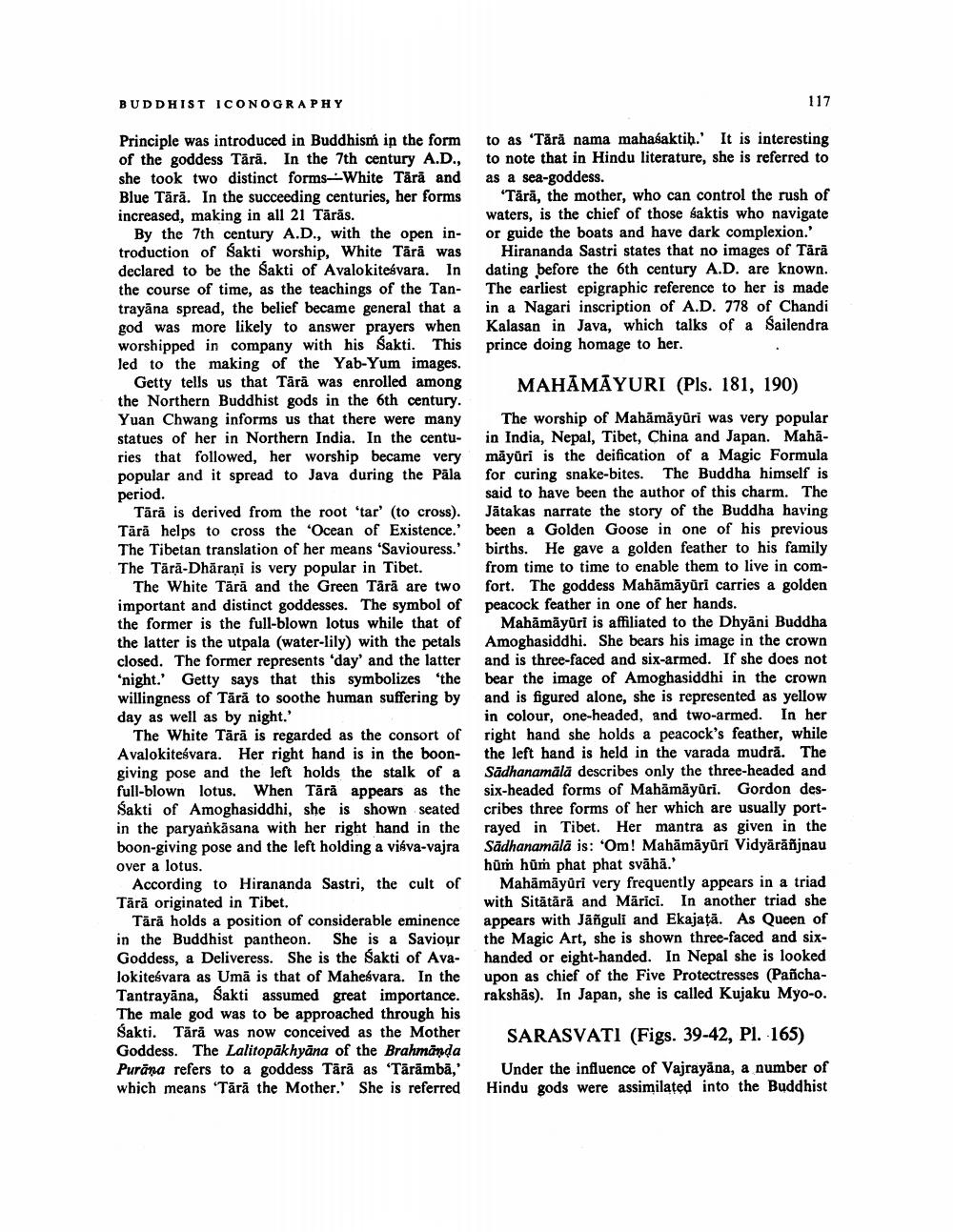________________
BUDDHIST ICONOGRAPHY
117
to as "Tără nama mahasaktih. It is interesting to note that in Hindu literature, she is referred to as a sea-goddess.
Tärā, the mother, who can control the rush of waters, is the chief of those saktis who navigate or guide the boats and have dark complexion.'
Hirananda Sastri states that no images of Tärā dating before the 6th century A.D. are known. The earliest epigraphic reference to her is made in a Nagari inscription of A.D. 778 of Chandi Kalasan in Java, which talks of a Sailendra prince doing homage to her.
MAHĀMĀYURI (Pls. 181, 190)
Principle was introduced in Buddhism in the form of the goddess Tārā. In the 7th century A.D., she took two distinct forms-White Tārā and Blue Tārā. In the succeeding centuries, her forms increased, making in all 21 Tārās.
By the 7th century A.D., with the open introduction of Sakti worship, White Tārā was declared to be the Sakti of Avalokitesvara. In the course of time, as the teachings of the Tantrayāna spread, the belief became general that a god was more likely to answer prayers when worshipped in company with his Sakti. This led to the making of the Yab-Yum images.
Getty tells us that Tārā was enrolled among the Northern Buddhist gods in the 6th century. Yuan Chwang informs us that there were many statues of her in Northern India. In the centu- ries that followed, her worship became very popular and it spread to Java during the Pala period.
Tārā is derived from the root 'tar' (to cross). Tārā helps to cross the "Ocean of Existence. The Tibetan translation of her means 'Saviouress.' The Tārā-Dhārani is very popular in Tibet.
The White Tārā and the Green Tärä are two important and distinct goddesses. The symbol of the former is the full-blown lotus while that of the latter is the utpala (water-lily) with the petals closed. The former represents 'day' and the latter 'night. Getty says that this symbolizes the willingness of Tārā to soothe human suffering by day as well as by night.'
The White Tārā is regarded as the consort of Avalokitesvara. Her right hand is in the boon- giving pose and the left holds the stalk of a full-blown lotus. When Täră appears as the Sakti of Amoghasiddhi, she is shown seated in the paryankāsana with her right hand in the boon-giving pose and the left holding a vibva-vajra over a lotus.
According to Hirananda Sastri, the cult of Tārā originated in Tibet.
Tärä holds a position of considerable eminence in the Buddhist pantheon. She is a Saviour Goddess, a Deliveress. She is the Sakti of Avalokitesvara as Umā is that of Mahesvara. In the Tantrayāna, Sakti assumed great importance. The male god was to be approached through his Sakti. Tārā was now conceived as the Mother Goddess. The Lalitopākhyāna of the Brahmanda Puräna refers to a goddess Tārā as "Tärämbā," which means "Tārā the Mother. She is referred
The worship of Mahāmāyūri was very popular in India, Nepal, Tibet, China and Japan. Mahamáyūri is the deification of a Magic Formula for curing snake bites. The Buddha himself is said to have been the author of this charm. The Jātakas narrate the story of the Buddha having been a Golden Goose in one of his previous births. He gave a golden feather to his family from time to time to enable them to live in comfort. The goddess Mahāmāyuri carries a golden peacock feather in one of her hands.
Mahāmāyūri is affiliated to the Dhyani Buddha Amoghasiddhi. She bears his image in the crown and is three-faced and six-armed. If she does not bear the image of Amoghasiddhi in the crown and is figured alone, she is represented as yellow in colour, one-headed, and two-armed. In her right hand she holds a peacock's feather, while the left hand is held in the varada mudră. The Sadhanamālā describes only the three-headed and six-headed forms of Mahāmāyüri. Gordon describes three forms of her which are usually portrayed in Tibet. Her mantra as given in the Sadhanamālā is: 'Om! Mahāmāyūri Vidyārāñjnau hùm hùm phat phat svāhā.”
Mahāmāyuri very frequently appears in a triad with Sitātārā and Mārici. In another triad she appears with Jānguli and Ekajață. As Queen of the Magic Art, she is shown three-faced and sixhanded or eight-handed. In Nepal she is looked upon as chief of the Five Protectresses (Pancharakshās). In Japan, she is called Kujaku Myo-o.
SARASVATI (Figs. 39-42, Pl. 165)
Under the influence of Vajrayana, a number of Hindu gods were assimilated into the Buddhist




